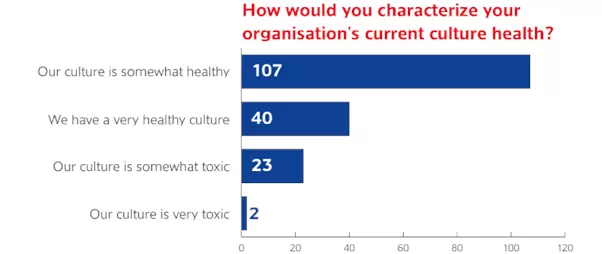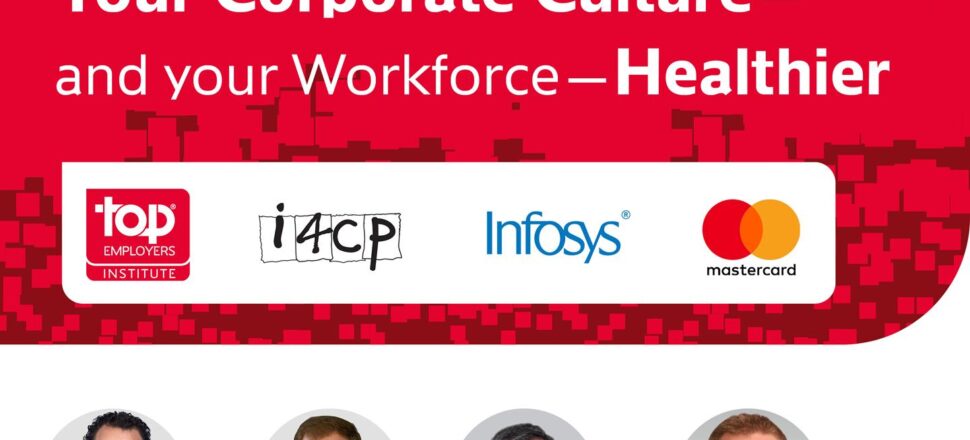Using HR Analytics to Make Your Corporate Culture—and your Workforce—Healthier
HR sits on a wealth of data today. Yet, when it comes to organisational culture, it’s often a struggle to analyse meaningful data for CEOs, boards, and senior business leaders and what data to present.
In this webinar, Kevin Oakes, i4cp CEO and author of Culture Renovation®, and David Plink, CEO of Top Employers Institute, explored how HR can most effectively leverage existing human capital analytics to measure and monitor cultural health.
Brandon Schassberger joined them, SVP Business Transformation, People & Capability at Mastercard and Richard Lobo, Executive Vice President & Head HR, Infosys, who shared how they use HR analytics at their respective companies.
The session started with a poll:

The number one answer was “Our culture somewhat healthy” (62%), followed by “our culture is very healthy” at 23%, making that a very good cumulative score of 85% of respondents saying somewhat or very healthy. i4CP, across various webinars and events, has asked this question, and the results are very similar.
i4Cp recently launched a survey to understand how companies deal with toxicity, even pockets of toxicity in their culture. And on the positive side, look at the elements of a healthy culture and what companies are doing to sustain that.
The risks of not using data
A notable trend is that many companies now have a lot of data – but many are not necessarily using it. There comes naturally with his associated risks. Kevin Oakes book “Culture Renovation: 18 Leadership Actions to Build an Unshakeable Company” emanated from a study done on corporate culture and the elements of a healthy culture overall.
And specifically, if companies want to change culture, how do they do it – a question many CEOs and senior executives posed. While the inherent importance of culture and the urgency to change it was understood, very little literature existed on ‘ how to do it. The book outlines 18 action steps that the organisation can take to renovate its culture.
Companies like Microsoft and Mastercard feature heavily in the book, as they have changed their culture over the last few years. They didn’t completely transform those cultures. Instead, they carefully renovated those cultures to keep what made them good, to begin with, to keep the unique elements of that organisation.
Kevin noted, “One of the very first steps, though, before you start changing our culture, is to understand the cultural elements today. And I tell executive teams this all the time. If you lock yourself in a conference room and decide amongst yourselves what the Culture is, you’re going to get it wrong.”
It’s important to understand the employee sentiment, probably even more so today where we got remote, flexible or hybrid work. Understand where employees feel the problem is before you set out to change it.
Engagement surveys are good for this, but they are at one point in time, and you don’t get a lot of great information in just one annual engagement survey. More companies are using newer technologies to listen on devices using natural language processing and a little AI to understand what’s happening in the workforce.
How Top Employer Infosys uses HR analytics to improve their corporate culture
Richard Lobo explained that Infosys has always used data for its clients. And unfortunately, not enough of the good work done by companies in the consumer space translates into the people space. The pandemic presented a great opportunity to accelerate the use of HR analytics.
Infosys, an organisation with close to 300,00 employees, provides lots of data. Data that allows you to predict, like an automated guidance system to your car or aeroplane.
In the pre-pandemic stages, many of us used to have water cooler conversations and would run into each other in corridors, and most of these moments have now moved into a virtual / tech space. As a consequence, the data produced by systems got that much richer.
Infosys uses HR analytics in various ways.
- The first is through a program labelled Hale (Health assessment and lifestyle enrichment. Through this, both mental and physical well-being data is collected. Based on the various application uses and programs, they can link them to absenteeism metrics. Furthermore, it provides input into how teams are doing and how many hours they can work without having a negative impact.
- The second program they use is called Lex – Learning Experience & Careers Adaptive Learning and Digital Career paths, based on employee insights on interests & skills. The online system can extract data to understand which skills are more in demand.
Conversely, Infosys also uses analytics to improve the employee experience and make work more ‘human’.
- On average, an employee goes through 200 touch points (for example, when they want approval, mark attendance, access employee data, etc.) through one mobile app. Improvements are made along the way by understanding how employees use the app through the data collected.
- Finally, through a program called MCode – Manager effectiveness, Infosys can collect data to develop managers and provide people insights on the go through interactive dashboards and nudges.
Richard also noted how the Top Employers Programme assisted Infosys “Because the whole certification experience, the interaction with the Top Employers team, has helped us advance the impact of people practices through shared learning.
Because we’ve learned so much from other companies because no company can get everything right. Being able to drive change because the whole certification process, the process regulation helps you use your data better, and they might apply some of these things on an on a real-time experience.”
How Mastercard used a Cultural Health Index to measure cultural trends
Brandon explains that Mastercard started their culture journey maybe 3-4 years ago, as they looked at things such as ISO categories and looked at metrics and the industry standards – which didn’t resonate with their cultures.
It’s great to have these metrics externally, but it didn’t provide any understanding or a way of measuring things that were important to them.
At the same time as undergoing this exercise, there was a lot of unrest in the USA. There was a strong push from stakeholders and asset managers to be much more transparent.
Through collaboration with i4CP, Mastercard had a breakthrough moment in conversation with Kevin Martin (Chief Research Officer at i4cp). Mastercard noted the modelling for reporting and the use of indices. So, instead of using 30 different KPIs, they could arrange them into indices: Innovation, Inclusion, and Employer Brand.
When these indices are aggregated and incorporate the retention statistics of Mastercard’s succession plans, they provide an objective, outcome-based view into the cultural trends that impact their organisation.
Breaking down one of those indices (Employer brand) – Mastercard recognised that they are one of the most valuable brands in the world – but this was not necessarily seen in their employer brand. Instead of only looking at their Glassdoor rating, for example, other perspectives were now being looked at – such as early career hires to customer voice of customer feedback to the engagement level of active people, Net promoter score, exits etc.
And thus, creating the indices helps you figure out what levers you have to pull and how they influence others.
Inside the Mind of the HR Analytics
“Without data, you’re just another person with an opinion.” – W. Edwards Deming
Data is one of the most important resources available to organisations. Leveraging data, can help organisations to develop and create efficient systems to improve their business practices. While data analysis has been used across different departments, it is often overlooked for its applications in HR teams.
As part of our Inside the Mind of the HRD series, Line Vercammen, HR Auditor at Top Employers Institute, and Britta Fischer, Standards Analyst and HR Researcher at Top Employers Institute, acknowledged the importance of getting and analysing HR data. Their knowledge, which was firstly shared in an internal presentation, was essential to this article as their presentation informed many of the points that this article hopes to reach.
We are regularly analysing the responses of Top Employers to understand how the world of work is changing on any given day. In our latest survey and in the validation sessions, HR Auditors at Top Employers Institute saw that some leading organisations are experimenting with predictive & prescriptive people analytics. With this kind of analytics, they get a prediction of the future via data analysis. That gives them more insights into the specific actions that need to be taken to achieve a certain goal.
An important question is if other companies, who have not yet began to work with their data, feel ready to ‘predict’ and look forward, instead of only looking back. Essentially, are more companies ready to break through the wall?
Descriptive analytics are more common than predictive analytics. This analysis tool is applied by many Top Employers worldwide. Already in 2022, we noticed that 87% of the Top Employers are translating their people strategy into key HR metrics (and related targets). This number increased by 12% since 2020 and it’s bond to keep growing.
You can find out more about thie and other trend downloading, for free, our World of Work Trend Report 2024 at the end of this article!
These numbers and their noticeable increase begin to paint a picture of the growing role for HR analytics for leading organizations. The painting is, however, unfinished and for many organizations the painting is something that they are looking to improve.
The use of HR analytics goes across many of the expected HR tasks like reporting on talent acquisition KPIs, but it also can be used in more interesting ways that may include the tracking and analysing the employee experience.
What are HR Analytics?
HR analytics offers a systematic process to drive business decisions about people. It offers businesses a way to use their data to uncover, interpret and communicate meaningful patterns in work-force related data to inform decision making while improving performance.
HR analytics cuts across the business and encompasses a data-driven solution for HR leaders to gain insights into the whole business. For this to succeed, there is a strong need to encompass a data-driven culture at the organisation level. We can see this in the number of Top Employers that have leaders that are committed to using HR analytics to make their decisions about their workforce.
While many organisations are beginning to embrace HR analytics, many are not getting the most out of their HR analytics because they are not yet at a stage where they can analyse them. In fact, many businesses are still merely reporting their data and not taking the next steps in leveraging that data.
This may be because many organisations do not yet understand the difference between the two activities.

The Differences between HR Analytics and Reporting Data
One way to explain the difference is to recognise that reporting summarises and organises data in easily digestible ways while analytics enables questioning and exploring that data further.
Where reporting focuses on reportable data, analytics is seeking to look at several points in the data to see if there is a link and do more work to uncover why the data is the way that it is. Reporting is a full stop, whereas analytics is an open question that can inform business decisions and strategies from a place of knowledge.
Three Ways Businesses can Integrate HR Analytics to their Benefits
Businesses need to move beyond merely collecting data and begin analysing the data if they are to move beyond the what and begin to explore the why.
This can be done in a variety of ways, but in this article, we will limit our exploration to three:
- HR needs to develop an expertise in their team to analyse the large amounts of people related data. This can be done by welcoming new members in their team that have a knowledge base that favours them proactively leading their team to analyse the data within their organisation. Organisations can also upskill and reskill the workforce in theri HR team so they do not leave anyone behind in the journey that their organisation will undertake in leveraging the HR data.
- Businesses will need to select relevant analytics software that they will be able to integrate across the organisation. The integration of this software is especially important in large multinational organisations as the data they will uncover may be more far reaching than their local workforce.
- HR teams will also need to embrace the ongoing and continuous collection and analysis of data. That is because data, and the patterns that can be drawn from it, is only effective if it is incorporated as a task that they do throughout the year.
HR Leaders and team members are beginning to understand that data-driven analysis is no longer a nice to have but an essential part of the business to improve decisions around their workforce.
The challenge, for HR leaders, is to adopt the use of HR analytics in their organisation with the right tools and an enthusiastic team that will lead them to have analytics that allow them to make strategic workforce decisions to improve their business performance. This can only be done with clear insight as they undertake this exciting work.
Learn more about the trends in people practices: download now our World of Work Trends Report 2024 for free.
World of Work Trends Report 2023
Top Employers Institute’s World of Work Trends Report 2023 analyses the latest trends in people strategies and practices from leading organisations globally. The report examined data from 2 053 Certified Top Employers to give a broader insight into how global developments will impact workforces in the year ahead.
What’s Inside?
Our latest research shows that the top 3 people priorities for these organisations in 2023 will be to create a high-performance culture, develop new leadership capabilities and align purpose, vision, and values. These three priorities reflect the following three key trends we have identified in our research.
Our contributing researchers and HR auditors explore the changes happening in the world of work, focusing on three major trends that are shaping global people practices:
The Employee Experience will become “super-personalised”.
We will see an unprecedented level of personalisation in the everyday employee experience. The personalisation of consumer needs has been a challenge for organisations and now employees expect to be treated as “internal” customers. The rise of individual employee needs will have much further to run in 2023 – what has been “people centric” will become “person centric”. Only those businesses that can go the extra mile in providing a genuine and heartfelt commitment to their people in this way will generate the emotional reaction necessary to enable a high-performance culture.
Leaders will actively listen for the “heartbeat” in their organisation.
Leaders will develop new strategic skills, particularly that of “listening to the heartbeat” of the organisation. Leaders are effectively having to “double screen” their working world. They need to simultaneously think about long term horizons, while acting decisively in the short term to survive, not to mention to thrive. They, and the next generation of leaders they nurture, will need to place a more committed listening strategy front and centre, to win the emotional commitment of their teams for in preparation for disruptive challenges.
Positive Impact – the new “North Star” for better decisions.
A clear commitment to “positive impact” will be the new North Star for everything that enlightened businesses do in 2023. Positive impact among our Top Employer organisations can be defined and achieved in three ways:
- A “lived” purpose that works best when it comes straight from the heart of all employees after all – and remains a constant in their everyday decisions.
- The positive impact made by an organisation can only ever be as good as the views that it allows itself to hear. So enlightened attitudes regarding diversity and inclusion are not only important in their own right, but also for the forward momentum they create in all organisations.
- Sustainability is key, both in the way an organisation ensures its own continuity through a positive wider impact – and in the way it is perceived and behaves as a good employer.
2023 will be all about these three trends. They will show a powerful human shift towards respecting individuality and valuing difference. It is vital that we attend to these needs because old management models are no longer useful. The best companies listen – truly listen – to their employees, invest in the individual experience, and create a shared purpose that gives meaning to the everyday employee experience. For organisations that achieve this, the future, despite the uncertainty we see all around us, will be very bright.


